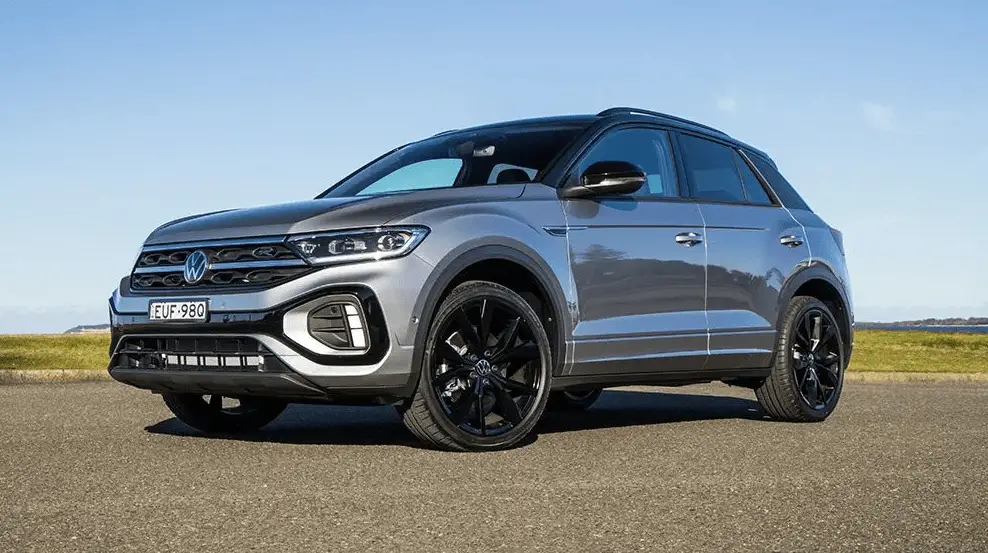2024 Volkswagen T-Roc Seats and Seat Belt Guide
With its carefully crafted seats and cutting-edge seat belt systems, the 2024 Volkswagen T-Roc establishes an astounding benchmark in the field of vehicle comfort and safety. As soon as passengers sink into the soft curves of the T-Roc’s seats, they are transported to a world of ergonomic luxury, with each curve and contour designed to offer unmatched comfort and support for every trip. The T-Roc’s seats provide a haven of leisure whether travelling cross-country or navigating through an urban jungle. They are outfitted with high-end materials and cutting-edge technology that take driving to new levels. Modern seat belt technology from Volkswagen, which seamlessly combines passive and active safety technologies, encases passengers in a protective cocoon and provides peace of mind and assurance on each journey. We dissect the finer points of the 2024 T-Roc’s seats and seat belt systems in this exhaustive investigation, revealing the engineering mastery and workmanship that epitomize Volkswagen’s dedication to passenger comfort and safety.
2023 – 2024 Volkswagen Atlas Review, Price, Features and Mileage (Brochure)
Introduction to the topic
Number of seats
The vehicle has a total of five seats: two at the front and three at the rear. Each seat is equipped with a seat belt. Assuming an incorrect sitting position considerably impairs the level of protection provided by a seat belt. This could lead to severe or even fatal injuries. The risk of severe or fatal injuries is especially increased when a deploying airbag strikes a vehicle occupant who has assumed an incorrect sitting position. The driver is responsible for all occupants transported in the vehicle, especially children.
WARNING
Assuming an incorrect sitting position in the vehicle can increase the risk of severe or fatal injuries during a sudden driving or braking manoeuvre, in the event of a collision or accident, or if the airbags are triggered.
- All vehicle occupants must assume a correct sitting position before setting off and maintain this position throughout the trip. This also applies to the fastening of seat belts.
- The number of vehicle occupants must never exceed the number of seats with seat belts in the vehicle.
- Never tilt the backrest too far to the rear.
- Always keep your feet in the footwell during the journey. Never place your feet on the seat or dash panel, for example. Never hold your feet out of the window. If you sit like this, the airbag and seat belt cannot provide optimal protection and could actually increase the risk of injury during an accident.
Correct sitting position
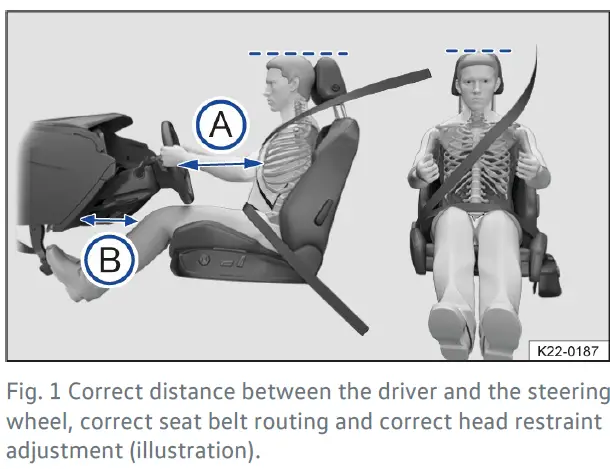
The following describes the correct sitting positions for the driver and passengers. The seat belts and airbags can only provide a maximum level of protection if a correct sitting position is assumed. If any vehicle occupants cannot assume a correct sitting position due to their physical build, they should contact a correspondingly qualified workshop to find out about possible special modifications. Volkswagen recommends using a Volkswagen dealership. Volkswagen recommends the following seating position for your own safety, for the most fatigue-free driving possible and to reduce the level of injury in the event of a sudden braking manoeuvre or an accident:
The following applies to all vehicle occupants:
- Adjust the head restraint so that its upper edge is at the same height as the top of the head, but not lower than eye level. Position the back of your head as close to the head restraint as possible at all times → Fig. 1.
- For small people, push the head restraint all the way down, even if the head is then located underneath the top edge of the head restraint.
- For tall people, push the headrestraint up as far as it will go.
- Always keep both feet in the footwell.
- Adjust and fasten seat belts properly.
Additional points for the driver:
- Sit as far back as possible on the seat.
- Adjust the driver seat by moving it forwards or backwards so that you are able to press the pedals to the floor with your knees still slightly bent and so that the distance from the dash panel to your knees is at least 10 cm (around 4 inches) → Fig. 1 B.
- Adjust the height so that you can reach the highest point of the steering wheel.
- Move the backrest into an upright position so that your back rests fully against it.
- The thighs should rest loosely on the seat. The back of the knees should protrude a few centimetres beyond the front edge of the seat. Use further equipment-dependent adjustment options for the seats (→ Front seat, mechanical) (→ Front seat, electric).
- Adjust the seat so that the distance between the steering wheel and your breastbone is at least 25 cm( around 10inches) → Fig. 1 A and the circumference of the steering wheel can be held at the sides with both hands and your arms slightly bent.
- The steering wheel must always point towards the breastbone and not towards the face.
Additional points for the front passenger:
- Move the backrest into an upright position so that your back rests fully against it.
- Push the front passenger seat as far back as possible so that the airbag can provide maximum protection if it is deployed.
Introduction to the topic
If worn properly, seat belts hold the vehicle occupants in the correct sitting position during an accident or braking manoeuvre, providing maximum protection.
WARNING
Incorrectly fastened or unfastened seat belts can increase the risk of severe or fatal injuries.
- Before every trip, each vehicle occupant must adopt the correct sitting position, correctly fasten the seat belt belonging to their seat and keep it fastened properly throughout the trip.
- Before every journey and while the vehicle is in motion, secure all children travelling in the vehicle in a restraint system suitable for their weight and height. They must also wear correctly fastened seat belts .
- Insert the latch plate only into the belt buckle of the corresponding seat and make sure that the latch plate engages securely. Using a buckle that does not belong to the seat that you are occupying reduces the level of protection and can lead to severe injuries.
- Never unfasten the seat belt while the vehicle is in motion.
- Never allow more than one person to share the same seat belt.
- Never transport children or babies on your lap and never secure them using the same seat belt as another person.
- Never travel wearing loose, bulky clothing (such as an overcoat over a jacket). This could prevent the seat belts from fitting and functioning properly.
WARNING
Damaged seat belts increase the risk of serious or fatal injuries. If the belt webbing or any other part of the seat belt becomes damaged, the seat belt may tear during an accident or sudden braking manoeuvre.
- Never damage the belt by trapping it in the door or in the seat mechanism.
- If the belt webbing, belt connections, belt retractor or seat belt buckle become damaged, the seat belt or belt attachment element in question must be replaced immediately by a suitably qualified workshop. The suitably qualified workshop must use correct spare parts that are compatible with the vehicle, equipment level and model year. Volkswagen recommends using a Volkswagen dealership.
- Never try to repair, modify or remove the seat belts or belt attachment elements yourself. All repairs to the seat belts, belt retractors and buckles must be carried out by a correspondingly qualified workshop. The correspondingly qualified workshop must replace the seat belt only with a seat belt that is approved for the seat in question. Volkswagen recommends using a Volkswagen dealership.
- Have seat belts that have been subjected to stress and stretched during an accident replaced by a correspondingly qualified workshop. Volkswagen recommends using a Volkswagen dealership. Renewal may be necessary even if there is no apparent damage. Also check the anchorages of the seat belts.
WARNING
Using seat belts incorrectly increases the risk of severe or fatal injuries.
- Regularly check to ensure that the seat belt and its related parts are in perfect condition.
- Always keep the seat belts clean.
- Avoid allowing foreign bodies or liquids to enter the seat belt buckle slots and belt buckles. This could prevent the seat belt buckle slots, belt buckles and seat belts from working properly.
- Never trap the seat belt. Never damage the belt or allow it to rub against sharp edges.
Seat belt warning system
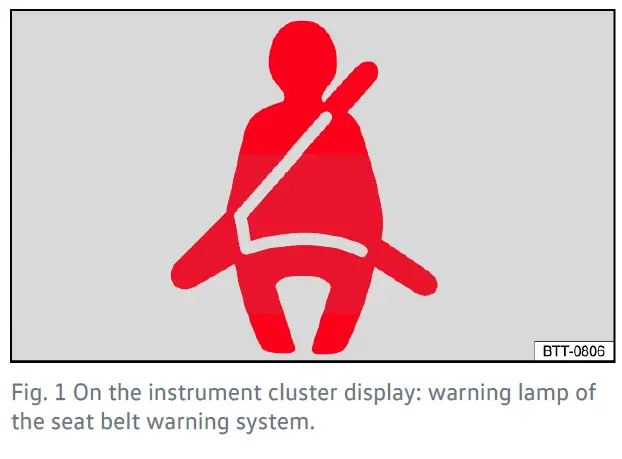
Seat belt warning for the front seats
If the driver or front passenger seat is occupied by an adult, an acoustic warning will be emitted for 126 seconds if the seat belts are not fastened at the start of a journey and the vehicle reaches a speed of more than approximately 25 km/h (15 mph) or if the seat belts are unfastened while the vehicle is in motion. The red ![]() warning lamp also flashes on the instrument cluster display. The red
warning lamp also flashes on the instrument cluster display. The red![]() warning lamp will not go out until all occupants have fastened their seat belts when the ignition is switched on.
warning lamp will not go out until all occupants have fastened their seat belts when the ignition is switched on.
Seat belt warning for the rear seats (depending on country and equipment)
When the ignition is switched on, the seat belt warning system shows the driver in the instrument cluster display whether or not the rear passengers have fastened their seat belts.
![]() The symbol indicates that the passenger on this seat has fastened their seat belt.
The symbol indicates that the passenger on this seat has fastened their seat belt.
![]() The symbol indicates that this seat is not occupied.
The symbol indicates that this seat is not occupied.
If a rear seat belt is unfastened when the vehicle is in motion, the ![]() and
and ![]() symbols for this seat will flash alternately, depending on the instrument cluster version. The red
symbols for this seat will flash alternately, depending on the instrument cluster version. The red ![]() warning lamp also flashes on the instrument cluster display. If the vehicle is travelling faster than approximately 25 km/h (15 mph) an acoustic signal will also be given for 126 seconds.
warning lamp also flashes on the instrument cluster display. If the vehicle is travelling faster than approximately 25 km/h (15 mph) an acoustic signal will also be given for 126 seconds.
WARNING
The seat belt warning system is designed to detect adult persons. If a seat is occupied by lighter persons, in particular children, the detection will not be reliable. The seat belt warning system also does not respond or responds only in a limited way if child seats and seat pads are used. As a result, the system may not be able to detect when lighter persons and children have not fastened their seat belts and this can lead to them suffering serious or fatal injuries in the event of an accident.
- Always ensure that all vehicle occupants, especially children, have fastened their seat belts properly.
Fastening and unfastening seat belts
Fastening the seat belt
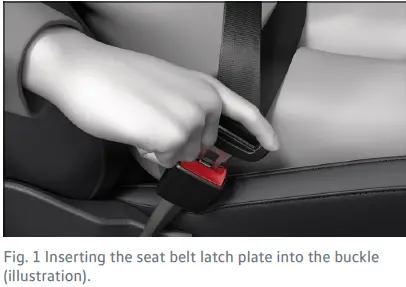
- Adopt correct sitting position (→ Sitting position).
- Take hold of the belt and pull it evenly across your chest and pelvis. Do not twist the belt when doing this (→ Seat belt routing).
- Insert the latch plate securely into the buckle belonging to the occupied seat→ Fig. 1.
- Pull on the seat belt to ensure that the latch plate is securely locked in the buckle.
Unfastening the seat belts
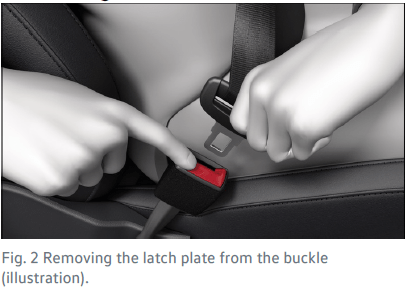
Unfasten seat belts only when the vehicle is stationary (→ Seat belt routing).
- Press the red button in the buckle → Fig. 2 . The latch plate is released and springs out.
- Guide the belt back by hand so that it rolls up easily, without twisting the seat belt and without damaging the trim.
Twisted seat belt
If it is difficult to remove the seat belt from the belt guide, the seat belt may have become twisted if it was returned too quickly into the side trim:
- Take hold of the latch plate then slowly and carefully pull out the seat belt.
- Untwist the seat belt and guide it back slowly by hand.
- Fasten the seat belt even if you are unable to undo the twist. However, the twist should not be in part of the seat belt that comes into direct contact with the body.
- Go immediately to a correspondingly qualified workshop in order to have the twist undone. Volkswagen recommends using a Volkswagen dealership.
Seat belt routing
Seat belts only provide an optimum level of protection during an accident when they are routed correctly. Correct seat belt routing reduces the risk of severe or fatal injuries. Correct seat belt routing also holds the vehicle occupants in position so that an inflating airbag can offer the maximum level of protection. Therefore you must always fasten your seat belt and ensure that the seat belt routing is correct → Fig. 1.
Correct seat belt routing
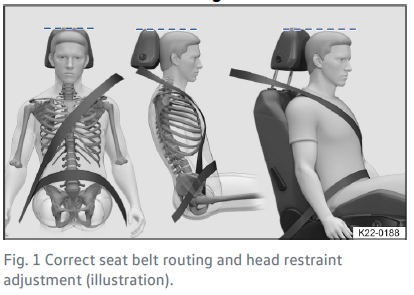
- The shoulder belt must always lie on the centre of the shoulder, never across the neck, over or under the arm or behind the back.
- The lap belt must always lie across the pelvis, never across the stomach.
- The seat belt must always lie flat and snugly on the body. Tighten the belt if necessary.
Correct seat belt routing during pregnancy
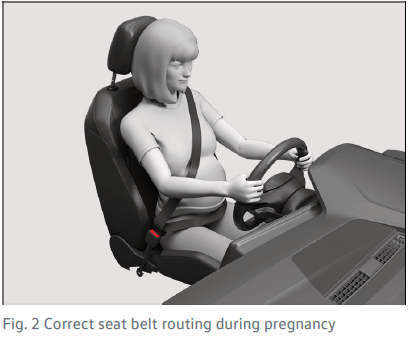
For pregnant women, the seat belt must be positioned evenly over the chest and as low as possible over the pelvis. It must lie flat so that no pressure is exerted on the lower body – this applies for the entire course of the pregnancy → Fig. 2 .
Correct seat belt routing according to height
The following equipment can be used to adjust the seat belt routing:
- Seat belt height adjuster for the front seats (→ Seat belt height adjuster).
- Height-adjustable front seats (→ Sitting position) .
WARNING
Incorrect seat belt routing can cause serious injuries in the event of an accident or a sudden braking or driving manoeuvre.
- Make sure that the seat belt routing is correct.
- Adjust the backrest to an upright position and fasten the seat belt correctly corresponding to your body size in order to achieve the optimum protective effect of the seat belts.
- Route the shoulder section of the seat belt over the centre of the shoulder and never under the arm or across the neck.
- Route the seat belt so that it lies flat and snugly on the upper body and pelvis. Pull the belt a little again to tighten it if necessary.
- Make sure that the lap part of the belt is routed in front of your pelvis and never over your stomach.
- If you are pregnant, make sure that the seat belt is routed evenly over your chest and as low as possible over your pelvis and so that it lies flat during the entire course of the pregnancy. In this way, no pressure is exerted on the lower abdomen.
- Do not twist the belt when fastening or wearing the seat belt.
- Never hold the seat belt away from your body with your hand.
- Do not route the belt over hard or fragile objects, such as glasses, pens or keys.
- Never change the belt routing by means of belt clips, retaining eyes or similar.
If a person’s physical build prevents them from routing the seat belt properly, contact a correspondingly qualified workshop to find out about any special modifications so that the seat belts and airbags can provide the optimum level of protection. Volkswagen recommends using a Volkswagen dealership.
Seat belt height adjuster
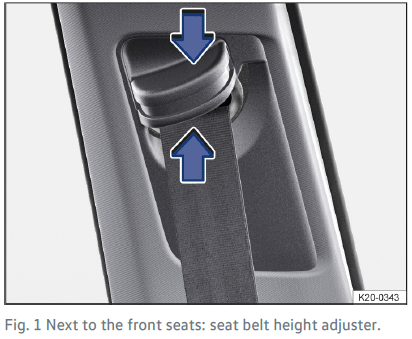
The seat belt height adjuster can be used to adjust the position of the seat belt on the shoulder so that the seat belt can be fastened properly:
- Press the button of the seat belt height adjuster together in the direction of the arrows and hold→ Fig. 1 .
- Push the seat belt height adjuster up or down so that the seat belt is routed over the middle of the shoulder (→ Seat belt routing) .
- Release the button of the seat belt height adjuster.
- Pull sharply on the seat belt to check that the seat belt height adjuster is engaged securely.
WARNING
If you adjust the belt height while the vehicle is in motion, this can cause serious and fatal injuries.
- Never adjust the seat belt height when the vehicle is in motion.
Belt retractor, belt tensioner, belt tension limiter
The seat belts in the vehicle are part of the vehicle safety concept . The vehicle safety concept has the following important functions:
Belt retractor
The seat belts on the driver seat and front passenger seat, as well as those on the outer rear seats(a nd on the middle rear seat, depending on the level of vehicle equipment), are fitted with an automatic belt retractor at the shoulder part of the seat belt. Full freedom of movement is ensured when the shoulder belt is pulled slowly or when the vehicle is travelling at normal speeds. However, if the belt is pulled out quickly or during sudden braking, during travel in mountains or bends and during acceleration, the belt retractor blocks the seat belt. Fastened seat belts on the front seats may be tensioned automatically by the proactive occupant protection system in critical situations, for example during an emergency stop or in the event of oversteering or understeering. Both seat belts are slackened again if the accident does not happen, or when the critical situation has passed. The proactive occupant protection system is ready to be triggered again.
Belt tensioner
The seat belts for the front seat vehicle occupants( and, depending on the vehicle equipment, on the rear outer seats) are equipped with belt tensioners. The belt tensioners are activated by sensors and tighten the seat belts during severe frontal, side and rear collisions and also possibly vehicle rollovers. Any slack in the seat belt is tightened. This can reduce the forward movement of the vehicle occupants and their movement in the direction of the impact. The belt tensioner works together with the airbag system. If the vehicle rolls over, the belt tensioner will only be activated if the curtain airbags are triggered. A fine dust may be produced when the airbags are triggered. This is quite normal and does not mean that there is a fire in the vehicle.
WARNING
The protective function of the belt tensioners permits only one activation of the belt tensioners. The system must be replaced if the belt tensioners have been triggered.
- Belt tensioners that have been triggered, and any affected system parts, must be replaced immediately with new parts that are approved by Volkswagen for the vehicle.
- Have repairs and modifications to your vehicle carried out only by a correspondingly qualified workshop. Correspondingly qualified workshops have the necessary tools, diagnostic equipment, repair information and qualified personnel. Volkswagen recommends using a Volkswagen dealership.
- Never install recycled belt tensioner components or components that have been taken from end-of-life vehicles in your vehicle.
- Never modify any components of the belt tensioners.
Reversible belt tensioning (proactive occupant protection system)
Reversible belt tensioning may trigger in certain driving situations . Examples include:
- Strong braking.
- Oversteer or understeer.
- Minor collisions.
The reversible belt tensioners may remain continuously tensioned after certain driving situations. In this case, the seat belts must be manually unfastened when the vehicle is stationary and then fastened correctly again in order to release the belt tensioning.
Belt tension limiter
The seat belts for the front seat vehicle occupants and on the rear outer seats are equipped with belt tension limiters. The belt tension limiter reduces the pressure exerted by the seat belt on the body during an accident.
- Observe all safety requirements when the vehicle or components of the system are scrapped. These requirements are known to the correspondingly qualified workshops (→ Belt tensioner) . Volkswagen recommends using a Volkswagen dealership.
Service and disposal of belt tensioners
Seat belts may become damaged during work on the belt tensioners or while removing or installing vehicle parts in conjunction with other repair work. This damage will not always be noticeable. The consequence may be that the belt tensioners could function incorrectly, or not function at all, in the event of an accident. Regulations must be observed to ensure that the effectiveness of the belt tensioner is not reduced and that removed parts do not cause any injuries or environmental pollution. These requirements are known to the correspondingly qualified workshops. Volkswagen recommends using a Volkswagen dealership.
WARNING
The risk of severe or fatal injuries may be increased if the seat belts, automatic belt retractors and belt tensioners are not used correctly, or if they are repaired by a non-professional. As a result, the belt tensioners may not be triggered when they should, or they may be triggered unexpectedly.
- Never carry out any repairs, adjustments or removal and refitting of parts in the belt tensioners or seat belts by yourself, and have such work carried out only by a correspondingly qualified workshop . Volkswagen recommends using a Volkswagen dealership.
- Seat belts, belt tensioners and automatic belt retractors cannot be repaired. They must be replaced.
The airbag modules and belt tensioners may contain perchlorate. Observe the legal requirements for disposal.
FAQs
The 2024 T-Roc typically offers a variety of seat options, including cloth, leatherette, and genuine leather upholstery, depending on the trim level and optional packages.
Yes, Volkswagen typically equips the seats in the 2024 T-Roc with multiple adjustable features such as height, lumbar support, recline, and fore/aft positioning, allowing occupants to customize their seating position for optimal comfort.
The 2024 T-Roc typically offers seating for five passengers, with two front seats and a three-person rear bench seat.
Depending on the trim level and optional features, the seats in the 2024 T-Roc may offer heating, ventilation, or both, providing enhanced comfort in various weather conditions.
The seat upholstery in the 2024 T-Roc may be made from various materials such as cloth, leatherette, or genuine leather, depending on the trim level and optional packages.
Yes, Volkswagen typically equips the 2024 T-Roc with a split-folding rear seatback, allowing occupants to fold down all or part of the rear seats to accommodate larger cargo items.
Yes, Volkswagen typically designs the seats in the 2024 T-Roc with ergonomic contours and supportive padding to provide comfort during long-distance journeys.
The 2024 T-Roc typically offers seat belts for five passengers, with three-point seat belts for all seating positions.
Yes, Volkswagen typically equips the seat belts in the 2024 T-Roc with adjustable height settings, allowing occupants to customize the fit for optimal comfort and safety.
The seat belt reminder system in the 2024 T-Roc typically activates a visual and audible warning if any occupant fails to fasten their seat belt before driving, reminding them to buckle up for safety.
Yes, Volkswagen typically equips the seat belts in the 2024 T-Roc with pretensioners, which automatically tighten in the event of a collision to reduce occupant movement and mitigate injury risk.
The seat belt tensioner system in the 2024 T-Roc typically activates in the event of a sudden deceleration or collision, tightening the seat belts to secure occupants in their seats and minimize injury risk.
Yes, Volkswagen typically equips the seat belts in the 2024 T-Roc with load limiters, which allow a controlled amount of slack in the seat belts during a collision to reduce chest and
shoulder forces on occupants.
Depending on the trim level and optional features, the seat belt comfort feature in the 2024 T-Roc may include padded shoulder straps or adjustable height settings to enhance comfort for occupants.
While it is not recommended, Volkswagen typically provides a method to deactivate the seat belt reminder system in the 2024 T-Roc, although doing so may compromise occupant safety and is not advised.
Useful Links
2023 – 2024 Volkswagen Atlas Review, Price, Features and Mileage (Brochure)

